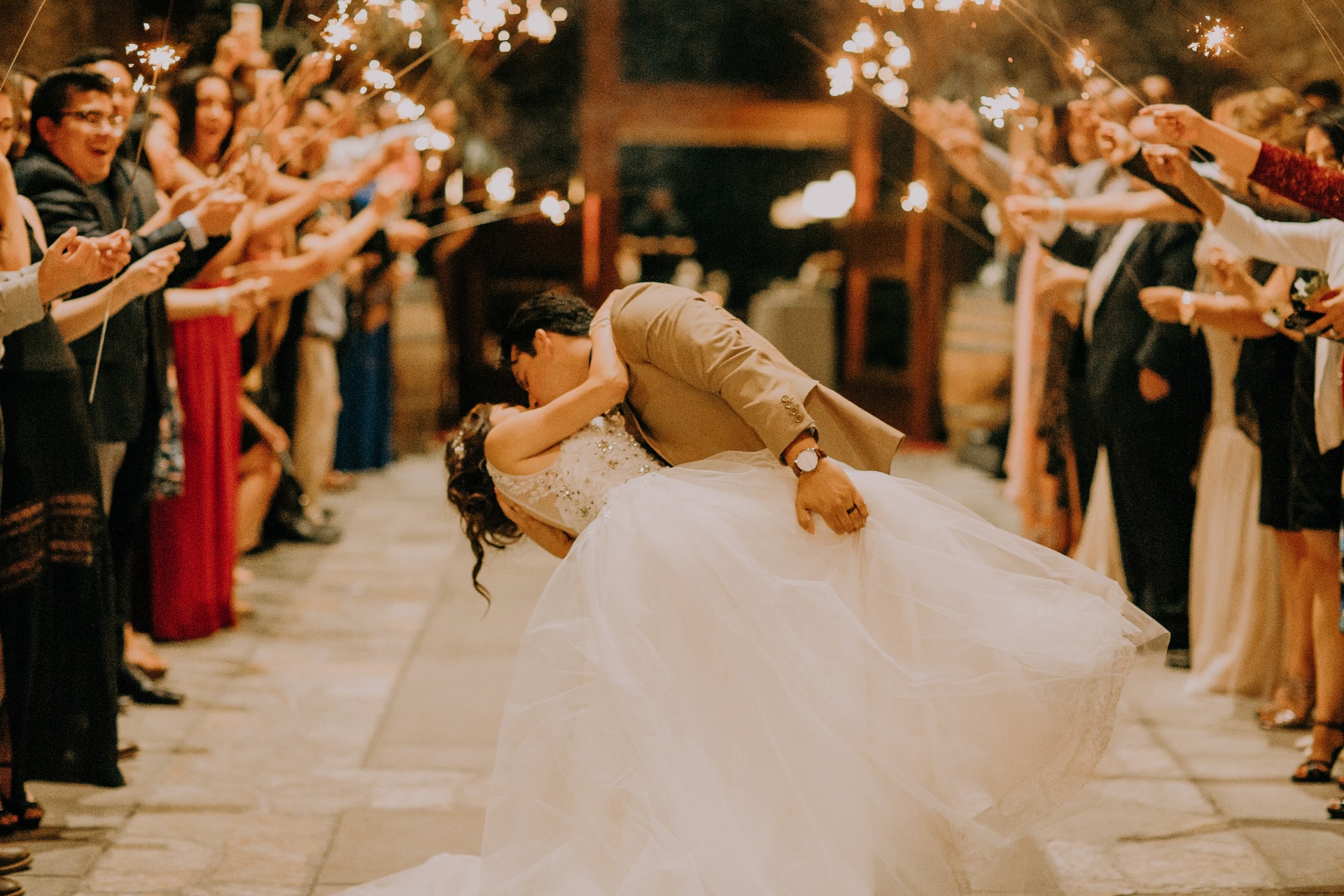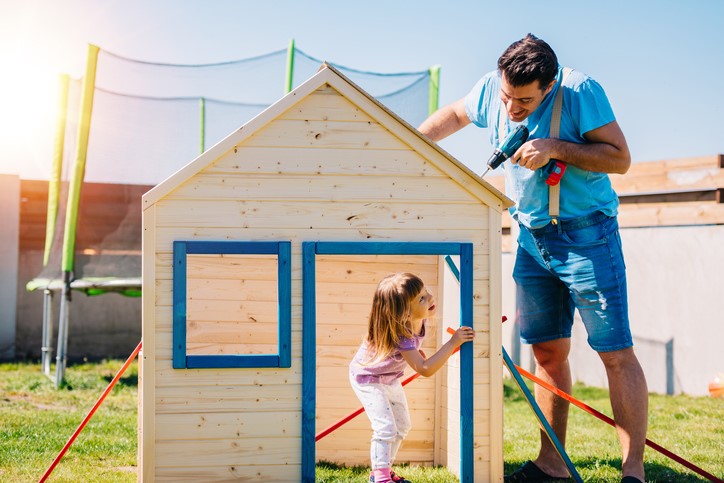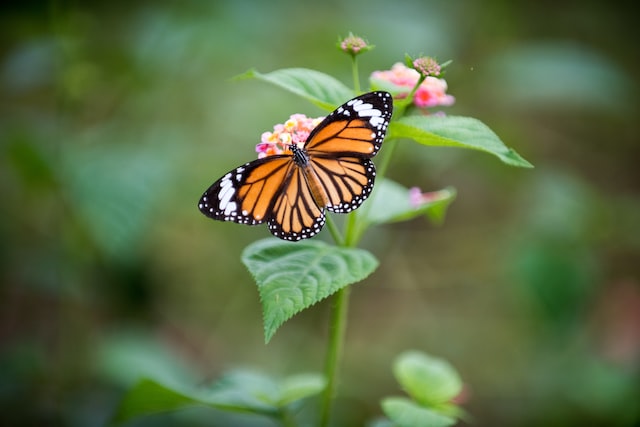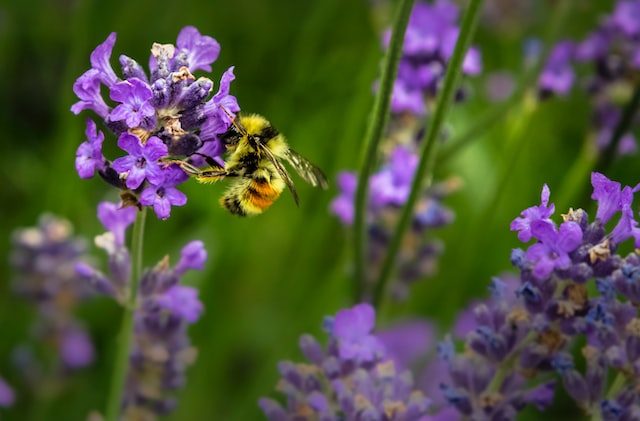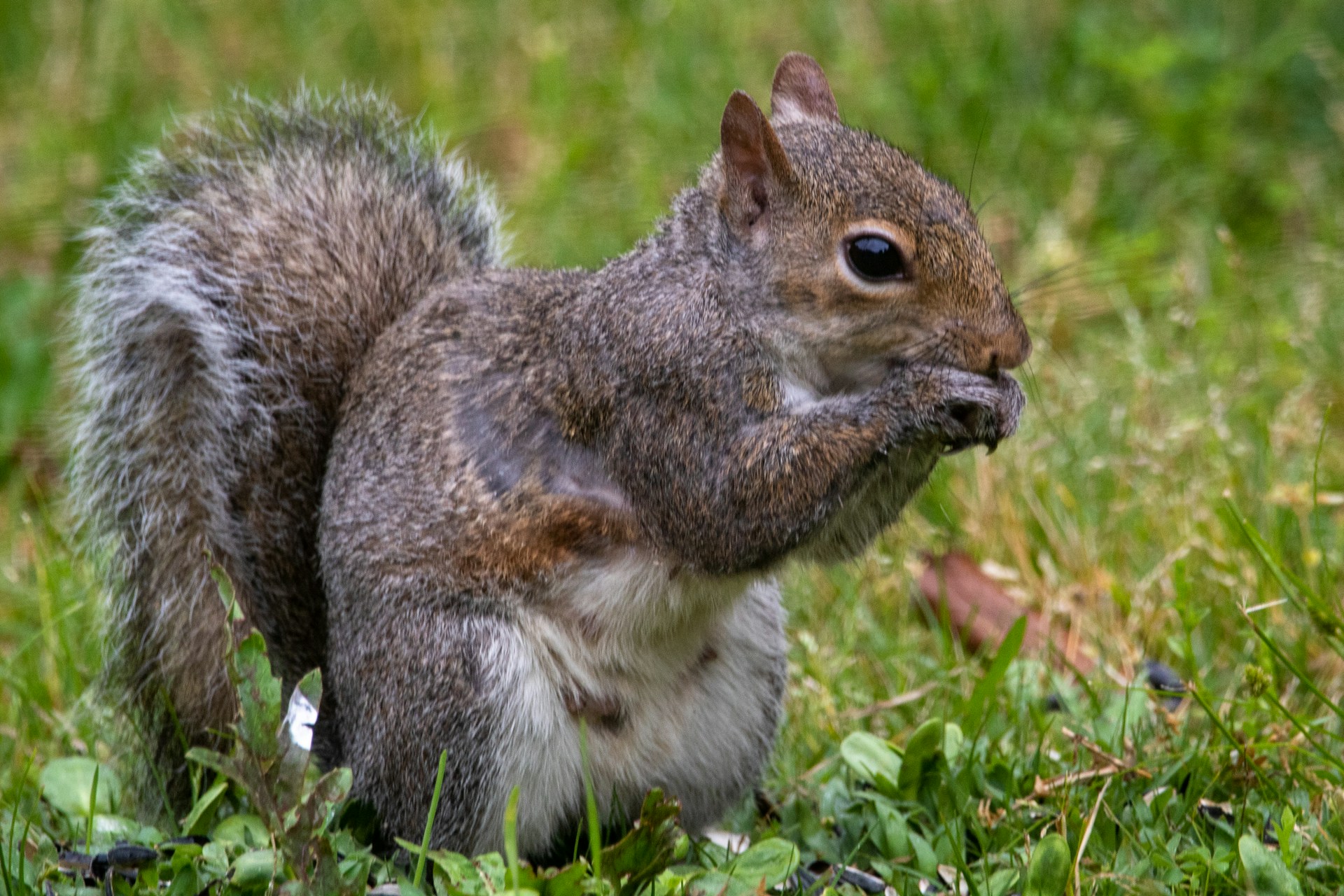Planning a wedding comes with a lot of emotions. It’s an exciting time; designing the invitations, choosing the right dress and tux, and tasting your wedding cake. However, planning a wedding can also bring stressful moments, such as making sure the seating arrangements fit everyone, preparing for unexpected weather, and getting different estimates from wedding planners. You may try hard to ensure everything up until the wedding goes perfectly, but not everything can be controlled. One of the biggest advantages of a backyard wedding is its cost-effectiveness. However, it’s still essential to plan your budget wisely to avoid unexpected expenses.
While there are many locations where you can have your wedding, your backyard is a nice intimate place to say, “Yes, I do.” Planning a backyard wedding might be slightly different than planning a wedding at another venue. That’s why we asked various experts, from photographers and wedding planners to bakers, for their opinions and tips.
Biggest trends people can do for weddings at home
A remarkable shift is underway in the realm of weddings as couples increasingly embrace hosting their special day at home. This evolution has given birth to many trends that reshape wedding ceremonies within the familiar confines of one’s space. Micro-weddings have emerged as a prominent trend, where couples opt for intimate gatherings focusing on quality interactions with a select group of loved ones. Backyards are being transformed into sophisticated settings through tasteful decorations, giving off an air of elegance. Personalization has taken center stage, with couples customizing every detail – from decorations to favors – with their unique story, ensuring an undeniably their event.
Advances in virtual technology have paved the way for global guest lists, enabling far-flung attendees to participate in events. Sustainability is also in the spotlight, with couples opting for eco-friendly choices, from farm-to-table catering to reusable decorations, aligning their celebrations with their values. With food trucks, interactive stations, and gourmet delights that tantalize the taste buds, dining experiences are reimagined. Meanwhile, entertainment has gone beyond the ordinary, with live performances, immersive acts, and cultural showcases enthralling guests.
In this journey to merge tradition with modernity, hybrid rituals combining diverse cultural elements are becoming increasingly common, celebrating the unity of backgrounds. These trends collectively suggest domestic weddings embody a more profound relationship – an intimate, personalized, and enduring covenant of love and togetherness.
What should be included in the backup plan for a backyard / at-home wedding?
Typically, spring and summer are the seasons for backyard weddings. Make sure you have a Plan B in place if you reside in a region where rains are frequent. If it rains, can you fit everyone in your home, or will you have tents in any case? Also, do the tents have fans in case the temperature becomes too high? The last thing you also need is for your visitors to complain about bugs crawling all over them. Unfortunately, this is a possibility if you decide to have your wedding outside. Prepare for it by purchasing insect spray and removing any probable infestation spots from the area.
Another thing to keep in mind is the bathroom situation. It’s doubtful that your home’s restrooms will be able to accommodate all of the partygoers’ demands. You don’t want your visitors to spend the entire day uncomfortable in line. Make plans for temporary restrooms. A generator should also be rented, and your water tanks should be full. To finish everything on time, you’ll need more help. The same holds for tidying up following the wedding. Plan properly and call for assistance when you need it. Instead of unwinding and enjoying the event, you don’t want to be too agitated and rushing about in the bustle.
Olga from Best for Bride
What are decoration ideas for a backyard wedding that will look wonderful in pictures and videos?
When it comes to decorating a backyard wedding or event, consider your surroundings and the time of year. If your garden will be in full bloom, you won’t need a lot, but I always love it when clients add in lush garden-style floral centerpieces. Lighting can be used for both decors and the event if your party will last past sundown. Consider setting up bistro lights or twinkly lights for trees or decorative lanterns for centerpieces. Make sure to add key focal decorations to your home or backyard areas that will be most visible to your guests. And also, consider the area that your guests will first enter through. An arch by a garden gate or wreath for the door could be a beautiful touch and will be a lovely first impression of the event.
What are some creative ways to incorporate personal touches into a backyard wedding?
There’s no better way to insert your personality into your wedding than by having it in your own backyard. Guests will be welcomed into your home and see you in every facet of the wedding. Take this opportunity to finally do the landscape design you’ve always dreamed of – grow all your favorite flowers, put up those funky string lights, paint your shed to match your wedding colors or draw a mural on it. By having the wedding in your own yard, you have all the control without being limited by venue restrictions. Bring out your grandmother’s best china that you inherited, cover the table with your precious knicknacks you’ve collected over the years, or hang mini-disco balls from all the trees – your only limitations are your own imagination and taste.
Katie Racine from Literally, Darling
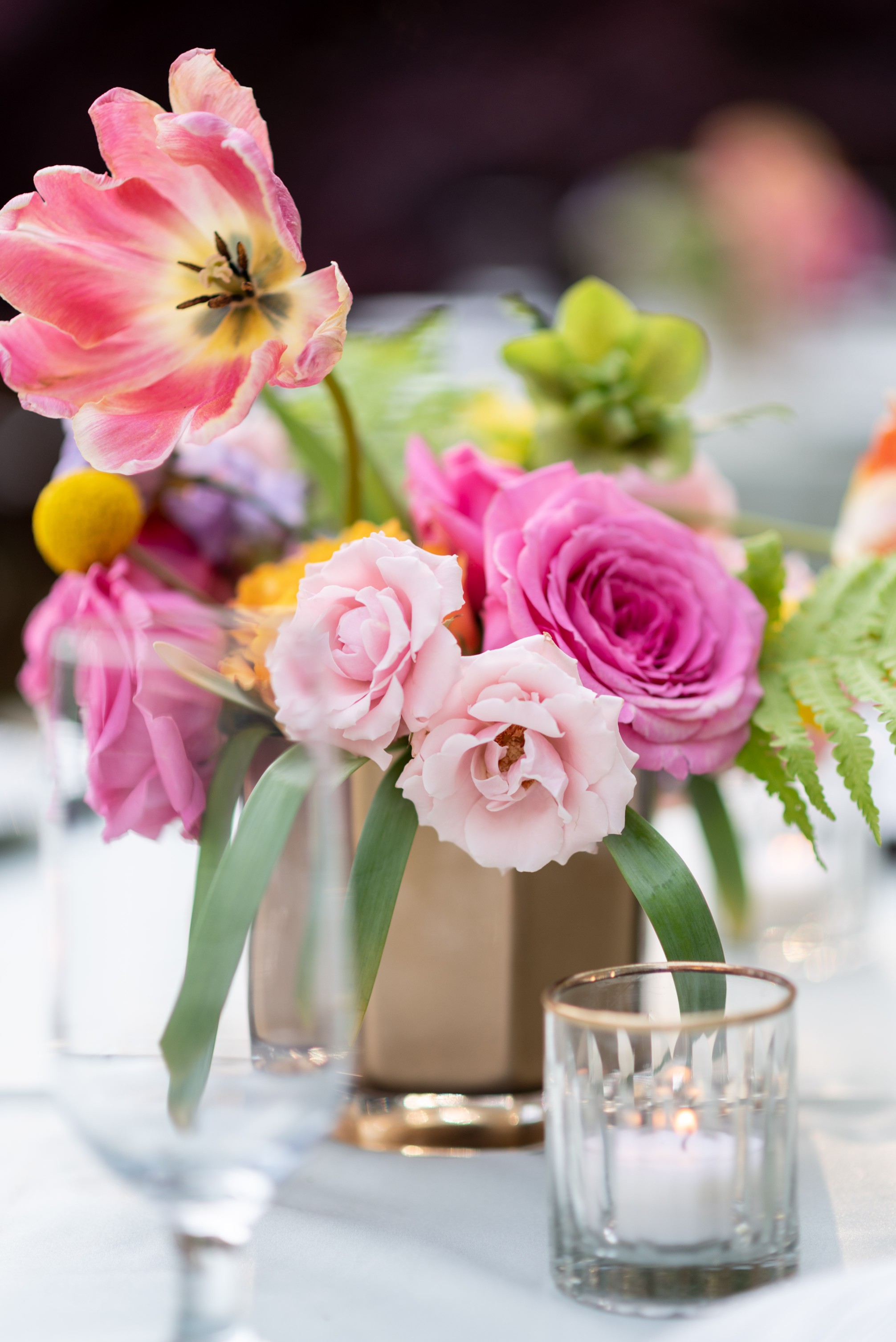
What are the benefits of hiring a professional photographer for your backyard wedding?
Your friends and family should be focused on celebrating and enjoying the most special moments and will naturally be caught up in them. This means they are likely to forget to take pictures at that time. A professional photographer knows all the right angles and moments to capture and is well versed in lighting conditions. Also, when it’s a friend or family member, editing is not their top priority. After the wedding, when they return to their busy schedules, you will be left waiting for photos of your big day.
Even though they will have had the best intentions going into it, after they realize that they have missed shots they thought they got, they will feel bad or be embarrassed and not want to show you the photos, and will likely delay leading to frustration and ultimately losing a friend. If you insist on going this route, don’t pick a close friend; make sure it’s someone you won’t mind losing contact with and not having your photos.
Susan from Susan Shek Photography
What are some tips for effectively communicating your vision and expectations to your photographer for a backyard wedding?
- Determine your vision: Envision how you want your backyard wedding to look and feel.
- Choose the right photographer: Find someone whose style aligns with your vision.
- Schedule a consultation: Discuss your vision and expectations with the photographer.
- Create a shot list: Collaborate with the photographer to outline important shots and details.
- Provide visual references: Share mood boards or examples to convey your desired aesthetic.
- Share your story: Communicate the personal elements you want to be captured.
- Discuss logistics: Talk about the timeline, lighting, and any unique challenges.
- Establish communication channels: Exchange contact information and preferred modes of communication.
Remember, effective communication is a two-way street. Be open to your photographer’s suggestions and expertise. The goal is to establish a collaborative relationship that brings your ideas to life.
How can a couple make their simple backyard wedding more exciting?
Here are a few things couples can do to turn their backyard into the perfect wedding venue. First, you want to remove branches, leaves, and dead plants from the grounds. Patch any bare spots in the grass and add flowers, bushes, etcetera matching your color palette (if within budget). Imagine the path your guests will roam throughout the day and plan wisely to avoid bottlenecking at the bar or bathrooms. Provide some cover with a tent in case of rain. Have a parking plan: if you have the space, great; otherwise, you may want to rent space from nearby lots or ask neighbors if a valet can park cars on their property. Having enough power is extremely important. Consult an electrician if you are unsure; average to large weddings will likely need generators. Some couples are uncomfortable lending guests access to their restrooms. In this case, you can rent portapotties or a more upscale option. Make sure you request information from your town, city, county, and state about permits, licenses, and restrictions. You may want supplementary insurance; a lot can go wrong at a wedding.
It’s important to note that backyard weddings are just as expensive or more expensive than traditional venues. They also require more work and planning. I recommend hiring a trusted planner with backyard wedding experience to help throughout the process. Make sure your photographer and videographer capture the landscape and layout of your backyard because it will never look the same again.
Your backyard is your home. A special place where you may have grown up, explored, played, and made lifelong memories. Incorporate what your home means to you in your design. You may want to include family photos or request the caterer make a recipe you loved growing up. Use your home and backyard as inspiration when adding personal touches.
Commemorate your wedding by planting a tree in your backyard. The tree will be a constant reminder of your wedding day as you watch it grow alongside your marriage. Bonus points if you plant the tree in the spot where you said: “I do.”
Jesse from Visual Event Films
What are the key considerations when deciding on an at-home wedding?
The biggest things to consider when planning an at-home wedding are the available space and your guest list. These two things go hand in hand to help you plan the best wedding for you and your guests to enjoy.
The space:
When planning an at-home wedding the first thing to consider is the space you have available. Will you allow guests inside the home? Do you have an accessible restroom? Is there a workable space for caterers, bartenders, and other vendors? Thinking about your used space, and creating a plan, will greatly help with the success of your home wedding and relieve stress on the big day!
Your guest list:
Of course, you want to spend your special day with all of your family and friends but, taking your space into account, invite those that are most important to you. If you invite too many people your home may feel cramped and overwhelming. If you narrow down your guest list too much your wedding day may be spent wishing you had invited more people to celebrate your love.
I could go on and on about the important things to consider when planning an at-home wedding but these are the two most important things to remember at the start of your planning process. Remembering these two key factors will help you and your partner to have an enjoyable day, celebrate with your friends and family, as well as sit back and see everything come together for the most joyful day!
Sophrona from Joyful Day Weddings
What can go wrong when planning a backyard wedding and how to prevent it?
The #1 thing that can go wrong with a backyard wedding is the weather! Depending on where you are having your wedding, you need to take typical weather into consideration. Don’t plan your wedding during a rainy or colder season. You also might want to take into account bugs. We have horrible mosquitos here in Illinois and even with treating our grass, they can still be bad at certain times during the year. It can literally ruin a party.
I’m sure that no matter where you live there is some element of weather or pests!
Always have a backup plan. A tent will work if you have light drizzle but if you have driving rain and lightning, the backyard just isn’t going to cut it. You need to have an alternative location either on the property or nearby.
If the day ends up being colder than expected, you might want to have sides and heaters on stand-by for your tent.
My other piece of advice is to have a “day of coordinator”. You’ll want to enjoy the day so that person can deal with any unforeseen issues that come up.
Lynn from Living Large in A Small House
What type of wedding dresses are perfect for a backyard wedding?
There’s nothing like a backyard wedding for casual elegance and a warm atmosphere. When you put these qualities into a wedding dress, you get a look that’s effortlessly stylish.
No matter what style you prefer or how much you can spend, there are hundreds of backyard wedding dresses for you to choose from.
For trendy brides-to-be looking for modern, simplistic designs, semi-structured sundresses and slip dresses make the perfect choice for a stylish wedding event.
Fashion-forward bridal suits and flower-patterned wedding dresses are always in style with brides who are style-conscious. Casual brides can choose relaxed silhouettes and comfortable dresses in cotton and linen that will complement their natural beauty.
In addition, there are a number of fabulous leg-baring mini dresses for the bride-to-be who have been searching for the perfect dress for the ceremony or after-party to wear. Before you ask, yes, a backyard wedding allows multiple outfit changes as well!
How can couples make their backyard wedding (more) sustainable?
- Send E-invitations for guests to attend your backyard wedding to save on paper. You can get creative with your e-invitation; it can be an image, a GIF, a video clip… or other formats.
- Have your wedding early during the day to save on light and electricity, otherwise, make sure to use LED or solar-powered lights for the night.
- Offer shuttle service to your guests from a focal point to cut down on the number of vehicles making the trip to your wedding.
- Use reusable decor items, eg, chalkboards for menus and signage, and mason jars for everything from centerpieces to drinking cups.
- Select caterers who resource from local communities, be it fruit and vegetable, meat and fish, or other food ingredients. Cut down on meats and include more vegan and vegetarian dishes in your buffet.
- Minimize the use of disposables by, for example serving water in glass jugs instead of plastic bottles, and using cloth napkins instead of paper napkins.
- Choose sustainable wedding favors: succulents, DIY soaps, homemade cookies, jam, local honey, lavenders… The ideas are endless.
- Minimize the use of flowers: choose green foliage, succulents, citrus fruits… If you still have to use flowers, select local, pot them, and donate them the following day, or use them as your wedding favors.
Samar from Arabia Weddings
What should the bride and groom consider when planning a backyard wedding?
Traditionally a wedding ceremony takes place in a Church, with the reception in a formal venue or hotel ballroom. But these days, most people opt for a more relaxed event. Having the ceremony on a beach or in a garden is becoming more the norm.
The wedding budget has become more important as people realize how expensive a wedding can be. Why spend all that money for one day when you can have a beautiful time in your own backyard?
When planning a backyard wedding, start planning early so you can avoid missing any elements. Come up with a theme that can be easily carried out, whether it be colors or a particular style. Choose a time of the year when the weather is predictable and comfortable for you and your guests. Have a backup plan if it looks like it may rain. If your celebration will go into the evening, choose appropriate lighting. Decorate inside your house as well as your guests will be going in and out. Hire items like chairs and catering equipment instead of purchasing just for one day.
Kim from Circle of Love
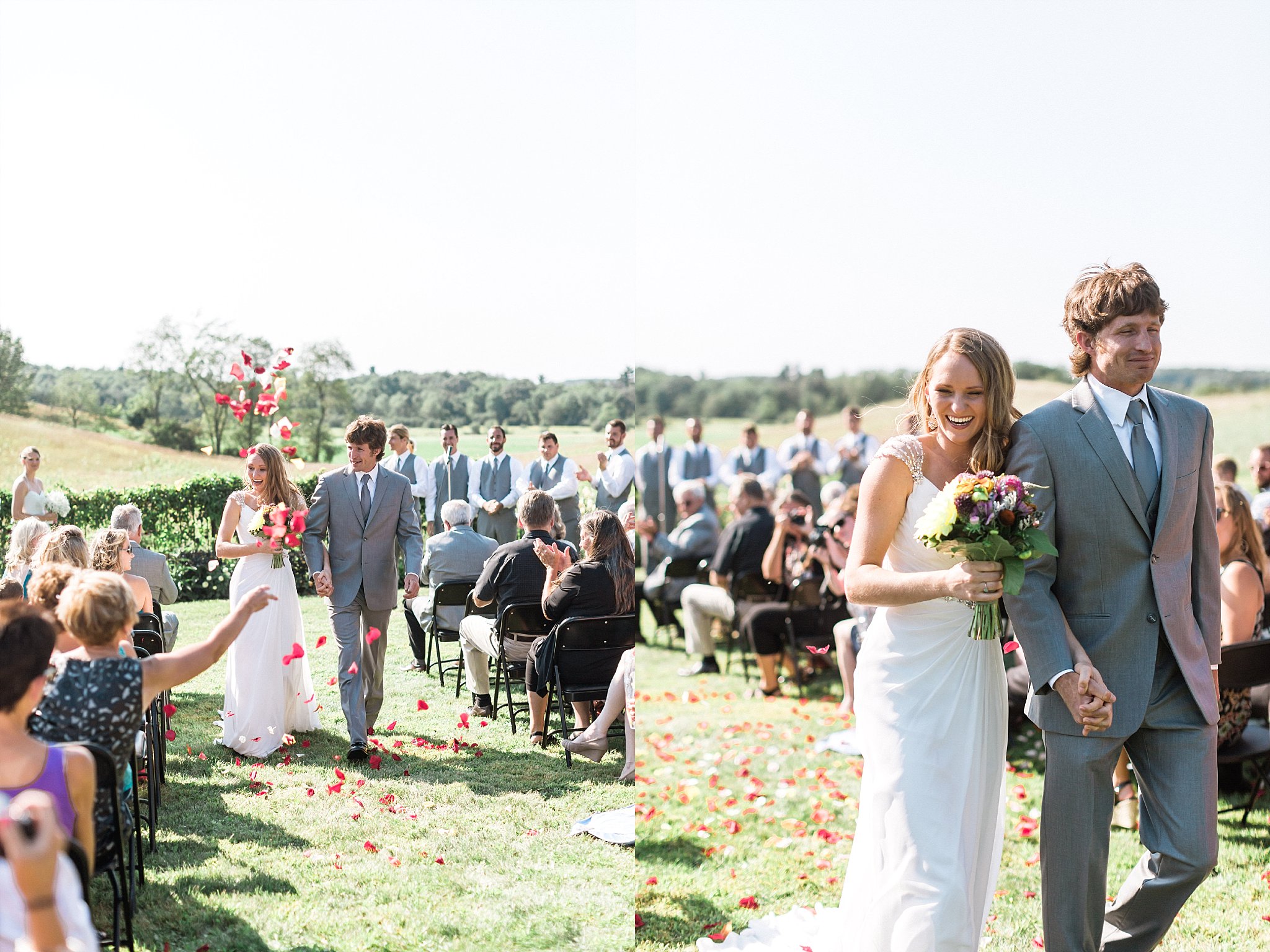
How far in advance can you make a wedding cake and how to store it?
What are the benefits of making your own wedding cake?
Ordering wedding cakes can be costly, depending on how big it is and how elaborate you want it to be. So one of the advantages of making your own wedding cake is that it will save you hundreds of dollars. The other major benefit is that you have total control over the kind of cake you want to be served at your wedding. Have you always been disappointed by cake elsewhere? By making your own wedding cake, you can control all aspects of the cake, from the taste, sweetness level, amount of frosting, color, and design. That being said, DIY-ing your own wedding cake does require research and practice, so a well-advanced preparation is a must!
Thinking of making your own wedding cake? I’ve shared all the recipes, timelines, resources, tutorials, and tips in my article to help your DIY wedding cake-making experience be a success and with as little hassle as possible.
Trish from The Bakeologie
How to take great outside photos in the dark?
How can you keep your neighbors onside when you’re getting married in your backyard?
There are some simple things you can do to ‘manage’ your neighbors if you’re thinking of getting married in your backyard.
Let the neighbors know as early as you can that you’re getting married in your backyard. Give them plenty of warning and be honest with them. Apologize in advance that it may be a one-off noisy night.
1. If you know the neighbors well, and you like them, invite them to your wedding!
2. Remind the neighbors the week prior to the wedding that you’re getting married in your backyard on a particular day and that it may be noisy.
3. Ask your guests to be mindful of the neighbors and moderate the noise levels as best you can without detracting from the fact it’s a wedding celebration.
4. The day prior to the wedding, give the neighbors a voucher for a movie or treat them to a meal at a nice café or restaurant – a gesture to acknowledge that you appreciate the fact that they will be inconvenienced, perhaps.
5. The day after the wedding, pack up some nice leftover food take it to your neighbors, and have a debrief about how your wedding went.
Bronte from BrontePrice.com.au
When organizing a backyard wedding, which services should be done professionally vs what can be done by the couple and family?
Some things in life are best left to the pros: reshingling your roof, cleaning a septic tank, or performing your own open heart surgery. When it comes to backyard wedding planning, however, there are a few DIY items that, with a little time and know-how, you can tackle yourself or with the help of friends and family.
One quick caveat: When considering the DIY route, be sure to take into account factors such as the amount of time required and, equally important, identifying where your skills lie (and where they don’t). With that said, here are a few items that you may wish to consider DIY’ing for your outdoor shindig.
- Planning: If you have a knack for planning and organization, you may be tempted to take on the actual planning of your big day. Keep in mind that planning is one of those deceptively simple tasks. Any bride will tell you that even with a planner, there are still a lot of moving parts to consider: organizing the itinerary of the day, sourcing and coordinating your vendor team, and, let’s not forget, all the day-of mayhem you’ll need to deal with. If you’ve got the stomach (and mind) for it, we’d say go for it.
- Light decor: Notice the word “light”. Unless you’re a Martha Stewart-level DIY’er with a passion for all things decor, you’re likely not going to have the time, energy, or inclination to put together two dozen centerpieces, a bouquet, your corsages, and all the other little touches you likely haven’t even thought of yet. Of course, if you’re the crafty type looking to save some big bucks, a little bit of sweat equity can definitely pay off.
- Food: depending on your guest count, catering your own food can be a huge cost-saving. One option in this regard is to consider a BBQ. Purchase and prep all the meet and then hire a chef to do the cooking. Desserts are also a relatively easy DIY option.
- Music: If your wedding is going to have an easy, casual vibe, you can likely create your own playlist for the big day. Of course, there’s no replacement for a quality DJ who can read and respond to the room, but if you’re looking to save a few bucks, this could be a good place to start.
- Organizing games/activities: now, here’s a great DIY line item. Part of the fun of hosting a backyard wedding is the fun and casual ambiance. Set up some games, rent them, or consider building them yourself if you (or someone you know) are handy: Giant Jenga, Cornhole, Connect Four, all totally doable with a little bit of know-how and elbow grease.
Stephanie from EventSource.ca
What is your best advice for outdoor wedding decoration?
When decorating for an outdoor wedding, you don’t have to limit yourself to a casual celebration. Using a seating chart can set a more formal mood and assures your close friends and family have a great view!
An outdoor tent set with beautiful place settings can instantly elevate dinner. Candles and string lights will add ambiance to your natural surroundings. Add comfy furniture by renting a settee or chairs, and add a table and rug for indoor coziness outside. Last tip: Plan for the weather! Umbrellas, throws, sunscreen, and fans can be placed in baskets for guests to grab.
Libbie from A Life Unfolding
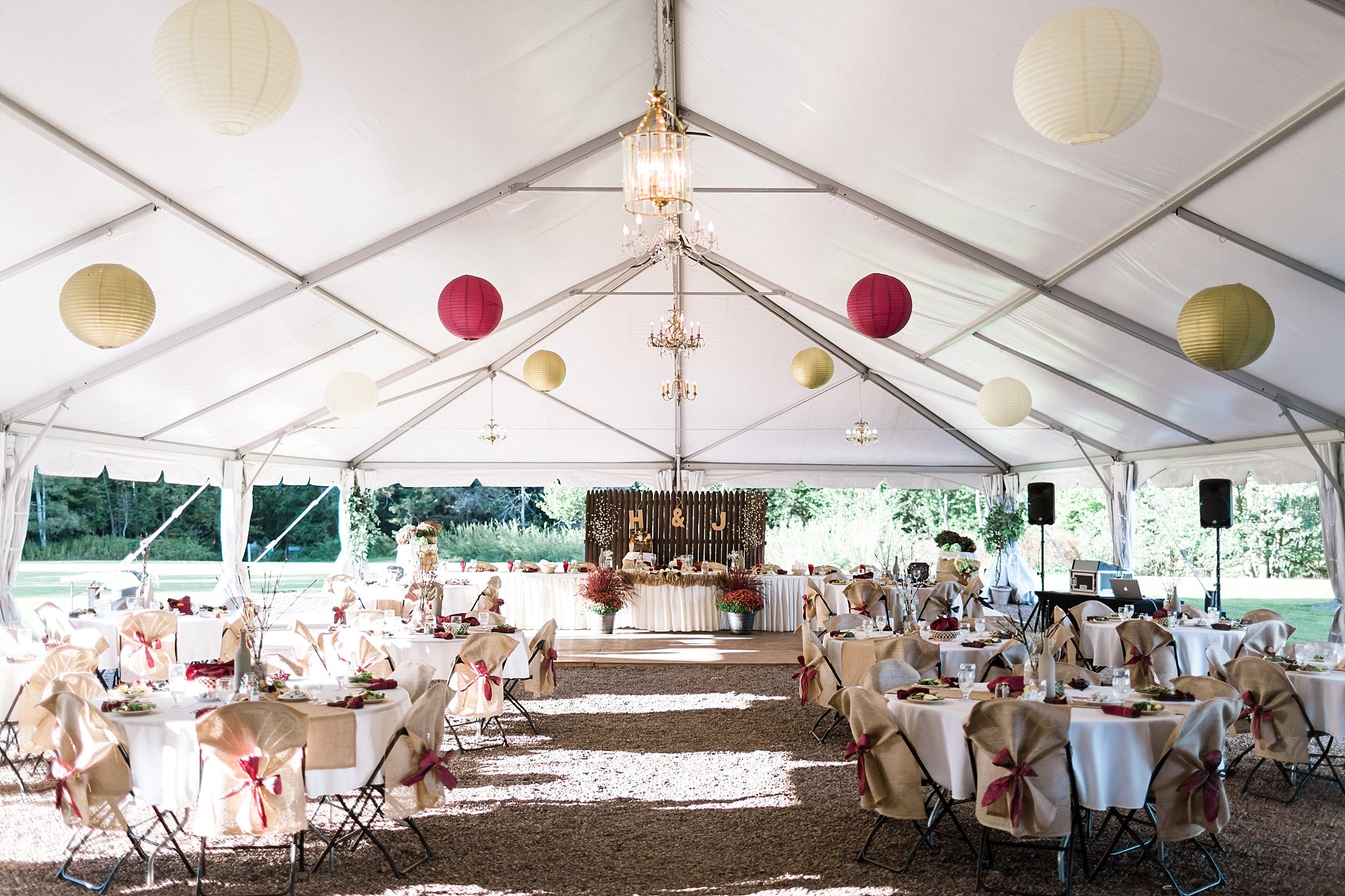
What is your best advice on DIY wedding flower centerpieces on a budget?
If you are considering using real flowers for your DIY centerpieces, aim to get flowers in your wedding colours that are in season during your wedding date or ones sourced from local growers at farmers’ markets to avoid having to ship from overseas.
Also, use what you already have around your home for your vases for a collective style. You can also buy some at the dollar store, online on Poshmark, or at your local thrift store. Once done, ask friends or family to help arrange the centerpieces.
Lastly, if you choose to use fake or faux flowers, make sure you buy them when they are on sale. Places like Michael’s Craft Store have a seasonal flower section and ones they have year-round, so keep an eye out for their weekly sales and get what you need in advance. If you are considering buying online, sign up for their newsletters and check out reviews from places like Ali Express before you order.
Shanice Bannis from City of Creating Dreams
Why do you recommend a printable wedding stationery planner for a DIY wedding?
There’s a lot to think about when planning a wedding. Whether you’re a great organizer with event planning experience or have never planned a birthday party, a printed wedding planner is necessary. No amount of preparation or thinking ahead is too much when it comes to your special day.
Because planning a wedding, when you get into all the to-dos, is downright daunting. This event involves checklists, worksheets, planning tips, ideas, and decisions. You can’t keep it all organized in your head. And a handful of notes stuffed into an envelope? Don’t even go there.
A printed wedding planner can cost a little or a lot, but by the time your big day arrives, you will be thankful that you took the time to write everything down. A binder-style planner is the best idea ever because as your planning progresses, you can switch sections, eliminate pages and add planning tabs you didn’t think you’d need when you started.
Using an app or online planner is great and can provide a lot of inspiration and organization. However, your time is valuable during this engagement period. And have you ever planned anything online without getting distracted and spending too much time chasing bunny trails? Only to find your time is used up and you need something to show. Use the apps and searches. But when you see a good thing, write it in your planner, then go on to something productive. Chasing too many ideas can seriously muddy your first vision of what you want your wedding to be.
Our final pro-paper planner point: writing your plans down increases your productivity. You get significantly more productive output by spending a few concerted minutes to plan. Planning how much you can spend on your wedding can help you stay within budget, so budgeting your time enables you to complete everything in time.
Dorothy Ensz from Kim & Ink
More wedding tips
In all the excitement and stress of wedding planning, one crucial aspect that should always be noticed is having a reliable wedding officiant. Counting on a seasoned officiant is paramount, as they are responsible for legally solemnizing your marriage and setting the ceremony’s tone. A skilled wedding officiant can personalize the ceremony to reflect your unique love story, beliefs, and values, making your wedding day meaningful and memorable. Their expertise and guidance can help you navigate the intricate details of the ceremony, ensuring that it aligns perfectly with your vision. With a wedding officiant by your side, you can confidently exchange your vows, knowing that this significant moment in your life is in capable hands, allowing you to focus on the joy and love surrounding your special day.
There is one more thing to consider when event planning, it might not be the most exciting topic, but it’s essential to make sure your special day goes smoothly. Home insurance can play a crucial role in protecting you in case of unforeseen incidents during your wedding. Here are some key points to consider:
- Liability coverage: Contact your home insurance provider to discuss your wedding plans. You’ll want to make sure that your liability coverage is adequate to protect you in case a guest is injured during the event.
- Rental equipment coverage: If you’re renting items like tents, tables, or chairs for the wedding, check if your home insurance covers any potential damage to these rented items.
- Damage to your property: Be aware of the potential for damage to your property during the wedding. If accidents occur or if your home gets damaged during the celebration, you’ll want to understand how your insurance can help with the costs of repairs.
- Special event insurance: In some cases, it might be wise to consider special event insurance. This type of coverage can provide additional protection specifically tailored to weddings and other special occasions.
- Review and update: If your wedding plans have changed significantly or if you’ve made improvements to your property in preparation for the event, it’s a good time to review and update your home insurance policy to make sure you have the right coverage in place.
Remember, it’s always a good idea to consult with your insurance provider to discuss the specifics of your wedding plans. This way, you can make any necessary adjustments to your home insurance so your big day is not only filled with joy but also well-protected.

A backyard wedding is a memorable moment to spend with your significant other, close friends, and family. While you might save on the venue costs when opting for a backyard wedding, make sure that everything else (clothing, e-invitations, wedding cake, tent rental, photography, etc.) is taken into consideration. This Q&A is a perfect guide to get you started. Don’t forget to have fun while planning your dream backyard wedding.
